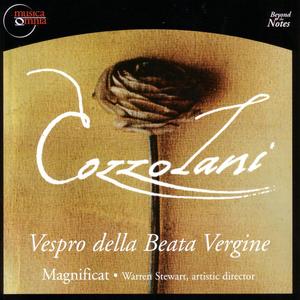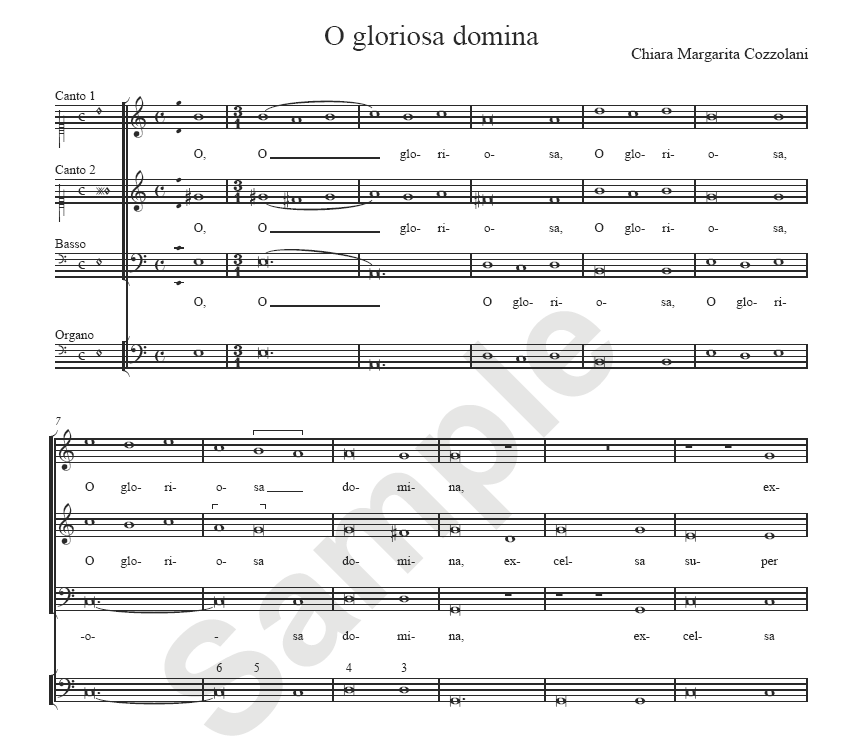O gloriosa domina
Composer: Chiara Margarita Cozzolani (1602-c1678),
c1640

| MIDI: not available |
| Lyrics:
http://music.cozzolani.com/track/cozzolani-o-gloriosa-domina |
O gloriosa domina, excelsa super
sidera.
Ave Maria, gratia plena, Dominus tecum,
benedicta tu in mulieribus.
O gloriosa domina, excelsa super sidera.
Ne timeas Maria, invenisti gratiam apud Dominum;
ecce concipies et paries filium.
O gloriosa domina, excelsa super sidera.
Dabit ei Dominus sedem David patris eius,
et regnabit in æternum.
O gloriosa domina, excelsa super sidera.
|
O glorious lady, exalted over the
stars.
Hail Mary, full of grace, the Lord is with you,
blessed art thou among women.
O glorious lady, exalted over the stars.
Do not fear, Mary, for you have found favor with the Lord; behold, you
shall conceive and bear a son.
O glorious lady, exalted over the stars.
The Lord will give Him the throne of David his ancestor, and He shall
reign for all eternity.
O glorious lady, exalted over the stars.
|
| Recording: |
|

|
play/stop MP3 sample:
CD: Cozzolani - Vespro della Beata Virgine |
|
Demo
score: |
|
 |

| Posted on YouTube: Not available at
this time. |
|
You could be
featured here!
If you (or your choir) perform this Ave Maria, make a video recording.
Post your video on YouTube, email me the page URL and I'll embed the video
in this page. |

You can also email me an MP3 for audio only. |

| Internet references,
biography information. |
|
http://en.wikipedia.org/wiki/Chiara_Margarita_Cozzolani |
Chiara Margarita Cozzolani (27 November 1602 –
ca. 1676-1678), was a composer, singer and Benedictine nun.[1] She spent her
adult life cloistered in the convent of Santa Radegonda, Milan, where she
became abbess and stopped composing. More than a dozen cloistered women
published sacred music in seventeenth-century Italy.[2]
Born into a wealthy family in Milan, Italy, Margarita Cozzolani entered the
convent and took her vows in 1620. She added "Chiara" as her religious
name.[3]
Her writings are very prolific, with some stylistic characteristics being
the usage of sequences and switching modes.[4] Her Concerti Sacri had
followed suit in the Lombard style.[5] Her four musical opere were published
between 1640 and 1650, which is the date of her Vespers, perhaps her
best-known single work. There is also a Paschal Mass. Her first publication,
Primavera di fiori musicali, is lost.[6] In the convent of Santa Radegonda,
the nuns sang during major religious feast days. This drew a great deal of
attention from the outside world. As abbess of Santa Radegonda, Cozzolani
defended the nuns' music, which came under attack from Archbishop Alfonso
Litta, who wanted to reform the convent by limiting the nuns' practice of
music and other contact with the outside world. The archbishop's qualms
could not have been reassured by the ecstatic report of Filippo Picinelli,
in Ateneo dei letterati milanesi (Milan, 1670) who found that "the nuns of
Santa Radegonda of Milan are gifted with such rare and exquisite talents in
music that they are acknowledged to be the best singers of Italy. They wear
the Cassinese habits[7] of St. Benedict, but they seem to any listener to be
white and melodious swans, who fill hearts with wonder, and spirit away
tongues in their praise. Among these sisters, Donna Chiara Margarita
Cozzolani merits the highest praise, Chiara in name but even more so in
merit, and Margarita[8] for her unusual and excellent nobility of
invention...".
Donna Chiara Margarita Cozzolani disappears from the convent's records after
1676. The first modern edition of her complete motets, for one to five
voices and continuo, appeared in 1998.[9]
|

Please notify us of any
broken/defective links

Page last modified:
May 02, 2013
Return to my homepage:
www.avemariasongs.org

|
![]()